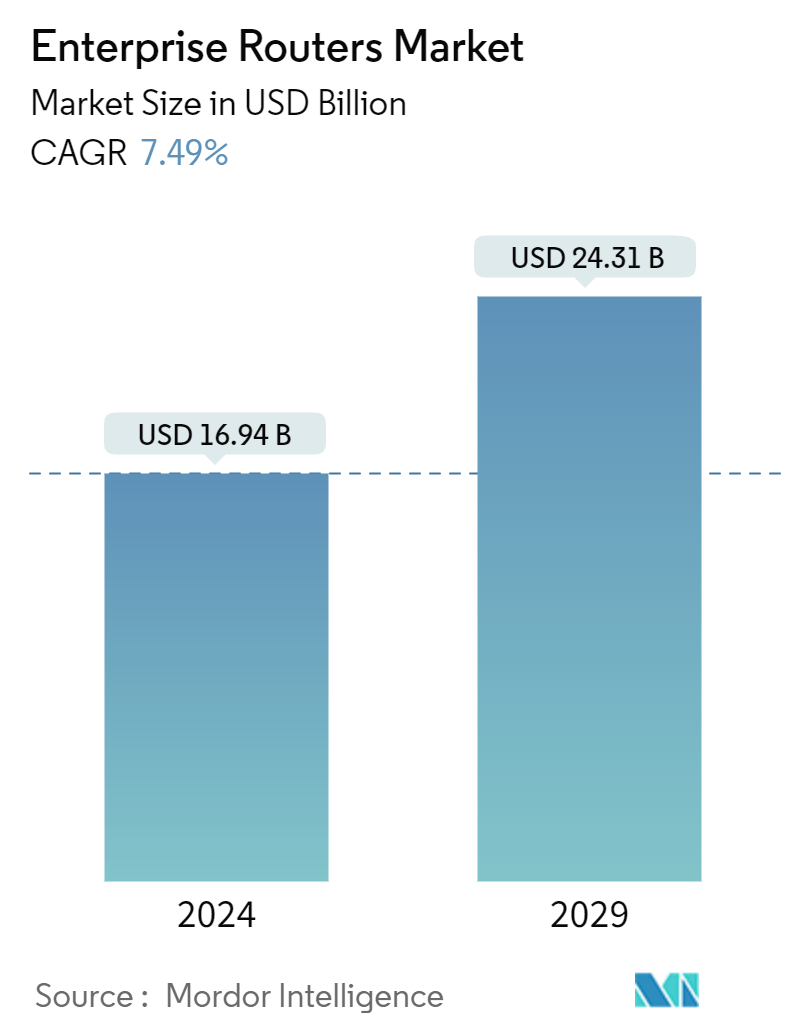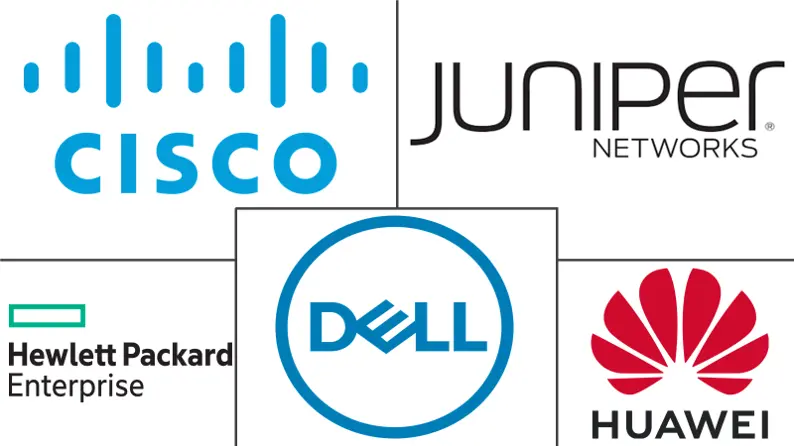Market Size of Enterprise Routers Industry

| Study Period | 2019 - 2029 |
| Market Size (2024) | USD 16.94 Billion |
| Market Size (2029) | USD 24.31 Billion |
| CAGR (2024 - 2029) | 7.49 % |
| Fastest Growing Market | Asia Pacific |
| Largest Market | North America |
Major Players
*Disclaimer: Major Players sorted in no particular order |
Enterprise Routers Market Analysis
The Enterprise Routers Market size is estimated at USD 16.94 billion in 2024, and is expected to reach USD 24.31 billion by 2029, growing at a CAGR of 7.49% during the forecast period (2024-2029).
Enterprise routers are essential products for any enterprise or organisation that uses them on a regular basis. By connecting computers and the Internet, they contribute to enterprises in a major way. Routers are capable of performing many functions, including enterprise routing which allows businesses to have greater CPU capacity for the management of placement tasks.
- Furthermore, it will enable enterprises to increase their network interface bandwidth for both wireless and wired circuits as well as use NetflowsFlow, MPLS, Quality of Service or any additional security features. It is equipped with features to integrate deep packet inspection and Wide Area Network acceleration.
- Enterprise routers are helping maximise productivity in the office, requiring an engineer's skill and experience to install them. An Enterprise Router can assist in maximising efficiency at your office, while an engineer's skills and experience are required to install the enterprise router.
- Huawei's Global Industry Vision predicts that by 2025, 85% of enterprise applications would be moved to the cloud, resulting in significant traffic growth at the part of egress of enterprise WANs. This development will be an exciting opportunity for market growth in the study area.
- Further, according to Cisco, the Internet of Things (IoT) has become a prevalent system in which people, data, processes, and things connect to the Internet and each other. Globally, M2M connections are estimated to grow 2.4-fold, from where 6.1 billion in 2018 to 14.7 billion by 2023. There would be 1.8 M2M connections for each member of the global population by the end of 2023. The increasing number of M2M connections are likely to boost the penetration of enterprise routers.
- Enterprise networking systems improve productivity at the workplace, but they require an engineering professional's expertise and training to install them. Private links are capable of several Mbit per second but they tend to be congested in the network, so service quality cannot be guaranteed. Adefined software wide area networks, which make use of flexible and efficient network management with applications, are the best solution.
- Moreover, in order to meet enterprises' growing demand for enhanced performance and better user experiences, the service providers are rapidly updating their networks. However, these services providers are still being hampered by inspection methods that need to be reviewed because of the adoption of virtualisation and SDN capabilities. New challenges have arisen in the area of migration to cloud computing for enterprises and an increased reliance on software applications from service providers, This has driven service providers to adopt NFV, SDN, and cloud-native computing technologies.
- To cater to the complex requirements of consumers, several companies are striving to launch new products and solutions. For instance, in June 2023, IP-COM announced the launch of its new enterprise routers M80 & M50. The M80 is a Gigabit enterprise router developed for high-requirement users, including hotels, enterprises, and community bandwidth operations.
- The router is furnished with a dual-core special 1.4GHz dual-core network processor with 4GB of high-speed DDR3 RAM. It embraces IP-COM enterprise system firmware utilizing a built-in intelligent AP management system, which can automatically distribute and maintain automatic AP configuration. It helps WEB account password authentication, PPPoE Server access authentication mode, WEB key authentication, and a few other securities which can satisfy the access authentication requirements under different scenarios.
- Moreover, due to the increasing disposable income, increasing penetration of smartphones and internet, shift in consumer behavior and changing lifestyles, the retail sector is witnessing robust growth. For instance, According to IBEF, India's retail industry is projected to grow by 9% from 2019-2030, from approximately USD 779 billion in 2019 to about USD 1,407 billion by 2026 and more than USD 1.8 trillion by 2030. The growth in the retail industry would aid the penetration of enterprise routers.
Enterprise Routers Industry Segmentation
The enterprise router market is growing as IP traffic increased five-fold during the past five years and is increasing exponentially. Hence, to support this massive growth in IP traffic, routers need to be upgraded, thus growing the enterprise routers market in various end-user segments, such as BFSI, IT and telecom, transport, etc. The market study comprises the type of connectivity, type of routers, and type of ports, which are being demanded differently in end-user vertical segments.
The enterprise routers market is segmented by type of connectivity (wired, wireless), type of port (fixed port, modular), type (core routers, multi-services edge, access router), end-user vertical (BFSI, IT & telecom, healthcare, retail, manufacturing), and geography (North America, Europe, Asia Pacific, Latin America, and Middle East & Africa).
The market sizes and forecasts are provided in terms of value (USD) for all the above segments.
| Type of Connectivity | |
| Wired | |
| Wireless |
| Type of Port | |
| Fixed Port | |
| Modular |
| Type | |
| Core Routers | |
| Multi-Services Edge | |
| Access Router | |
| Other Types |
| End-user Vertical | |
| BFSI | |
| IT & Telecom | |
| Healthcare | |
| Retail | |
| Manufacturing | |
| Other End-user Verticals |
| Geography*** | |
| North America | |
| Europe | |
| Asia | |
| Australia and New Zealand | |
| Latin America |
Enterprise Routers Market Size Summary
The enterprise routers market is poised for significant growth, driven by the increasing demand for robust networking solutions that support both wired and wireless communications. These routers are crucial for enterprises as they enhance network interface bandwidth and integrate advanced features like deep packet inspection and Wide Area Network acceleration. The shift towards cloud computing and the proliferation of Internet of Things (IoT) devices are further propelling the market, as businesses seek to manage the growing volume of data traffic efficiently. Companies are continuously innovating, with new product launches aimed at meeting the complex networking needs of modern enterprises. The market is characterized by a mix of global players and emerging companies, all vying to capture a share of the expanding demand for enterprise networking solutions.
North America stands out as a key region in the enterprise routers market, with a strong presence of major vendors and significant investments in data center infrastructure. The region's growth is fueled by the increasing need for hyperscale data centers and the adoption of cloud-native computing technologies. Initiatives like "Make in America" are expected to further boost local manufacturing, providing additional opportunities for market expansion. The market landscape is competitive, with companies like Cisco Systems, Juniper Networks, and Huawei Technologies leading the charge in innovation and strategic partnerships. As enterprises continue to embrace digital transformation, the demand for enterprise routers is anticipated to rise, offering lucrative prospects for market participants.
Enterprise Routers Market Size - Table of Contents
-
1. MARKET INSIGHTS
-
1.1 Market Overview
-
1.2 Industry Value Chain Analysis
-
1.3 Industry Attractiveness - Porter's Five Force Analysis
-
1.3.1 Threat of New Entrants
-
1.3.2 Bargaining Power of Consumers
-
1.3.3 Bargaining Power of Suppliers
-
1.3.4 Threat of Substitute Products
-
1.3.5 Intensity of Competitive Rivalry
-
-
1.4 Impact of COVID-19 and Macro Economic Trends on the Industry
-
1.4.1 Threat of New Entrants
-
-
-
2. MARKET SEGMENTATION
-
2.1 Type of Connectivity
-
2.1.1 Wired
-
2.1.2 Wireless
-
-
2.2 Type of Port
-
2.2.1 Fixed Port
-
2.2.2 Modular
-
-
2.3 Type
-
2.3.1 Core Routers
-
2.3.2 Multi-Services Edge
-
2.3.3 Access Router
-
2.3.4 Other Types
-
-
2.4 End-user Vertical
-
2.4.1 BFSI
-
2.4.2 IT & Telecom
-
2.4.3 Healthcare
-
2.4.4 Retail
-
2.4.5 Manufacturing
-
2.4.6 Other End-user Verticals
-
-
2.5 Geography***
-
2.5.1 North America
-
2.5.2 Europe
-
2.5.3 Asia
-
2.5.4 Australia and New Zealand
-
2.5.5 Latin America
-
-
Enterprise Routers Market Size FAQs
How big is the Enterprise Routers Market?
The Enterprise Routers Market size is expected to reach USD 16.94 billion in 2024 and grow at a CAGR of 7.49% to reach USD 24.31 billion by 2029.
What is the current Enterprise Routers Market size?
In 2024, the Enterprise Routers Market size is expected to reach USD 16.94 billion.

